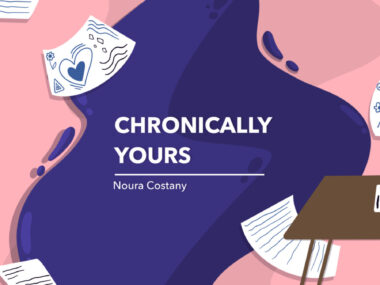Vision problems aren’t something I usually discuss — until now
I often wonder if my visual snow syndrome is related to Cushing's disease
Written by |

Some of the most difficult symptoms I deal with from chronic illness are vision problems. It’s something I haven’t talked about publicly before.
Four years ago, around the time I was diagnosed with Cushing’s disease, I was also diagnosed with visual snow syndrome, a condition that’s exactly as it sounds: My vision appears as if I were looking through a snow globe.
I remember going to different doctors in a panic that I was losing my vision. When I finally got answers about what was happening, it wasn’t what I wanted to hear. A neurologist, an ophthalmologist, and a neuro-ophthalmologist all told me there was nothing they could do about it. I’d just have to get used to it.
Doctors suspect that my vision problems are related to my Cushing’s disease, but they don’t have proof. Researchers still don’t know what causes visual snow syndrome, but it started happening to me around the same time I became ill from Cushing’s disease.
How it affects me
In addition to seeing static all the time, visual snow syndrome causes me frequent migraines and anxiety. Sometimes it feels almost like my eyes are vibrating. When that happens, I have to open and close my eyes repeatedly until they feel normal again.
The first pituitary tumor I had was removed with transsphenoidal surgery, and I recovered quite well. For a little over a year, I felt fantastic. But doctors and I eventually realized that a second tumor had formed.
Before that surgery, I’d see static over everything, like looking at an old television set. It was hard to see anything. It’s not as bad today, but I do see a lot of floaters, particularly when I’m looking at light surfaces such as sidewalks and clouds. I also have night blindness and can barely see a few feet in front of me in the dark. Lastly, my vision is sometimes blurry and some objects seem like they’re glowing.
Being told that my vision will always be like this and that there’s nothing I can do about it is incredibly frustrating. That being said, I’ve learned to adjust.
Visual snow syndrome is one of the reasons I use my wheelchair. I think many people assume that I use it only because of muscle weakness, but moving around at night gives me anxiety and headaches. I’m grateful to have my mobility aids and a partner who can help me.
My husband and I have a favorite “visual snow” story: On April Fools’ Day, I turned off the lights and tried to scare him by sneaking up on him. But instead of being surprised, he just laughed and remarked, “You know I can see you, right?” I’d forgotten about my vision problems and thought that since I couldn’t see him in the dark, he couldn’t see me, either.
We still laugh about that interaction. As frustrating as these issues are, it’s great that I’ve gotten used to them and that I finally feel comfortable discussing them.
I’m hopeful that one day this syndrome will be better understood and have a treatment, but I’m not holding my breath. In the meantime, I’m working on living with it, just as I am with Cushing’s disease and my other conditions.
You can also follow my journey on TikTok and YouTube.
Note: Cushing’s Disease News is strictly a news and information website about the disease. It does not provide medical advice, diagnosis, or treatment. This content is not intended to be a substitute for professional medical advice, diagnosis, or treatment. Always seek the advice of your physician or other qualified health provider with any questions you may have regarding a medical condition. Never disregard professional medical advice or delay in seeking it because of something you have read on this website. The opinions expressed in this column are not those of Cushing’s Disease News or its parent company, Bionews, and are intended to spark discussion about issues pertaining to Cushing’s.







Nina.
I have similar eye issues, but not as severe. For me it is worse in my left eye and definitely got better after my pituitary surgery in March 2023, but it has gotten worse again…. so I’m wondering if another pituitary adenoma has started to form. My pituitary adenoma was not interfering with the vision nerve, but I’m still confident my eye problems are Cushing related.
I had most of my floaters removed in both my eyes and that helped with my night vision as well as reading.